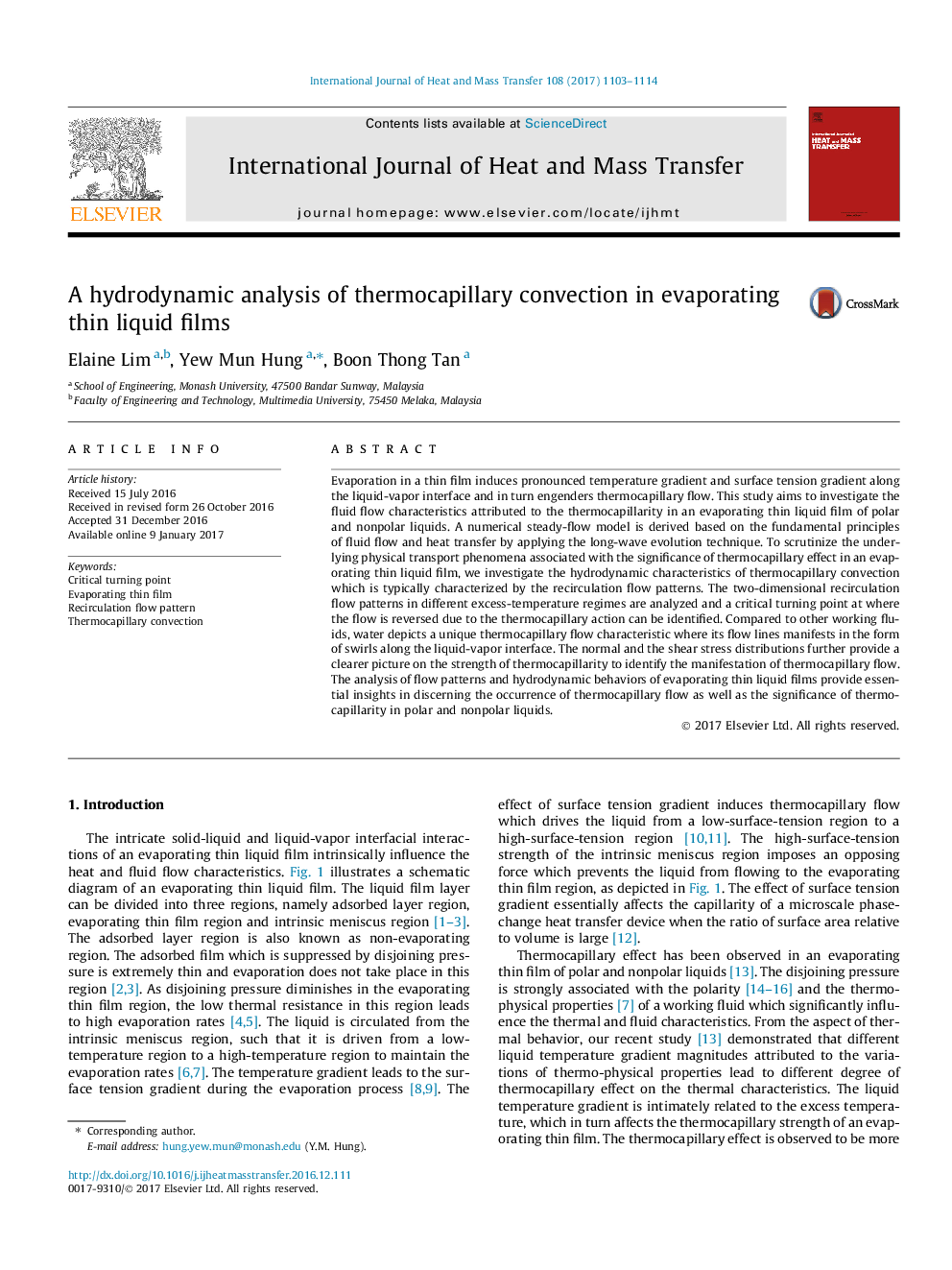| کد مقاله | کد نشریه | سال انتشار | مقاله انگلیسی | نسخه تمام متن |
|---|---|---|---|---|
| 4994345 | 1458034 | 2017 | 12 صفحه PDF | دانلود رایگان |
عنوان انگلیسی مقاله ISI
A hydrodynamic analysis of thermocapillary convection in evaporating thin liquid films
ترجمه فارسی عنوان
تجزیه و تحلیل هیدرودینامیکی حرارتی ترموکاپیلی در تبخیر کردن فیلم های نازک مایع
دانلود مقاله + سفارش ترجمه
دانلود مقاله ISI انگلیسی
رایگان برای ایرانیان
کلمات کلیدی
نقطه عطف انتقادی، تبخیر فیلم نازک، الگو جریان گردش جابجایی ترموکاپیلا،
ترجمه چکیده
تبخیر در یک فیلم نازک سبب ایجاد درجه گرادیان درجه حرارت و شیب سطحی در امتداد رابط مایع بخار می شود و به نوبه خود باعث جریان گرماسنجی می شود. این مطالعه با هدف بررسی ویژگی های جریان سیال نسبت به ترموکاپیلی بودن در یک فیلم مایع تبخیری مایع قطبی و غیر قطبی انجام شده است. مدل جریان ثابت عددی بر مبنای اصول اساسی جریان سیال و انتقال حرارت با استفاده از روش تکامل طول موج مشتق شده است. برای بررسی پدیده های حمل و نقل فیزیکی زیرمجموعه با اهمیت اثر ترموکاپیلیال در یک فیلم مایع نازک تبخیری، ویژگی های هیدرودینامیکی ترانسکاپیال ترموکاپیلار را بررسی می کنیم که به طور معمول توسط الگوهای جریان تجدید جریان مشخص می شود. الگوهای جریان احیا دو بعدی در رژیم های مختلف بیش از حد دمای تجزیه و تحلیل می شوند و نقطه چرخش بحرانی در جایی که جریان به دلیل عمل گرماکاپیلی می تواند شناسایی شود. در مقایسه با سایر مایعات کاری، آب یک ویژگی جریان جریان منحصر به فرد را نشان می دهد که خطوط جریان آن در شکل سوپاپ ها در امتداد رابط مایع بخار ظاهر می شود. توزیع تنش برشی و نرمال، تصویری روشن تر از قدرت ترموکاپیلیتری برای شناسایی تظاهرات جریان ترموکاپیلیتری ارائه می دهد. تجزیه و تحلیل الگوهای جریان و رفتارهای هیدرودینامیکی تبخیر از فیلم های نازک مایع، بینش ضروری را در تشخیص وقوع جریان ترموکاپیلیال و همچنین اهمیت ترموکاپیلی بودن در مایعات قطبی و غیر قطبی، فراهم می کند.
موضوعات مرتبط
مهندسی و علوم پایه
مهندسی شیمی
جریان سیال و فرایندهای انتقال
چکیده انگلیسی
Evaporation in a thin film induces pronounced temperature gradient and surface tension gradient along the liquid-vapor interface and in turn engenders thermocapillary flow. This study aims to investigate the fluid flow characteristics attributed to the thermocapillarity in an evaporating thin liquid film of polar and nonpolar liquids. A numerical steady-flow model is derived based on the fundamental principles of fluid flow and heat transfer by applying the long-wave evolution technique. To scrutinize the underlying physical transport phenomena associated with the significance of thermocapillary effect in an evaporating thin liquid film, we investigate the hydrodynamic characteristics of thermocapillary convection which is typically characterized by the recirculation flow patterns. The two-dimensional recirculation flow patterns in different excess-temperature regimes are analyzed and a critical turning point at where the flow is reversed due to the thermocapillary action can be identified. Compared to other working fluids, water depicts a unique thermocapillary flow characteristic where its flow lines manifests in the form of swirls along the liquid-vapor interface. The normal and the shear stress distributions further provide a clearer picture on the strength of thermocapillarity to identify the manifestation of thermocapillary flow. The analysis of flow patterns and hydrodynamic behaviors of evaporating thin liquid films provide essential insights in discerning the occurrence of thermocapillary flow as well as the significance of thermocapillarity in polar and nonpolar liquids.
ناشر
Database: Elsevier - ScienceDirect (ساینس دایرکت)
Journal: International Journal of Heat and Mass Transfer - Volume 108, Part A, May 2017, Pages 1103-1114
Journal: International Journal of Heat and Mass Transfer - Volume 108, Part A, May 2017, Pages 1103-1114
نویسندگان
Elaine Lim, Yew Mun Hung, Boon Thong Tan,
